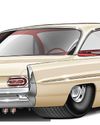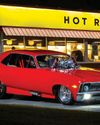
No experienced engine builder would intentionally bolt a cylinder head to an engine block without installing a gasket between the block and cylinder head. The gasket seals the block deck surface to the cylinder head surface. Smooth-looking metal has microscopic surface roughness and waviness that creates leak paths, especially under high cylinder pressures. The gasket fills the voids and contains those high pressures. That's why high-horsepower engines O-ring the blocks and heads. Those same microscopic peaks and valleys exist on the cylinder walls, piston rings, and piston-ring grooves. Motor oil acts like a gasket to seal those components together.
If you've ever leakdown tested an engine-hot or cold-you've probably seen a difference in the readings. Part of that is due to the thermal expansion of the parts, but also from the amount of oil on the cylinder walls and piston rings. A cylinder with a dry wall and piston ring will leak more than one that's wet with motor oil, which is why mechanics sometimes squirt oil into a cylinder through the spark plug hole before doing a compression or leakdown check. It might seem that a smoother surface finish on the cylinder wall would be the answer, but a certain amount of roughness is needed to hold the oil, as with the block deck.
I experienced this firsthand back when NASCAR and NHRA Pro Stock teams began to experiment with mirror-smooth bore finishes. The idea was to reduce friction, but these super-smooth bores didn't retain enough oil. As a result, blow-by increased and crankcase vacuum decreased.
This story is from the June 2023 edition of Hot Rod.
Start your 7-day Magzter GOLD free trial to access thousands of curated premium stories, and 8,500+ magazines and newspapers.
Already a subscriber ? Sign In
This story is from the June 2023 edition of Hot Rod.
Start your 7-day Magzter GOLD free trial to access thousands of curated premium stories, and 8,500+ magazines and newspapers.
Already a subscriber? Sign In

What Is Pro Street?
You know it when you see it.

Pro Street in Pure Vision
Builder Steve Strope weighs in on the Pro Street look and what he would build today.

THE GAS ERA LIVES ON
These vintage race cars chart the evolution of technology in the early days of drag racing.

MOTOR HEAD FOR LIFE
Scott Sullivan is one of the original Pro Street pioneers. He still builds cars today out of a small shop in Dayton, Ohio.

BRINGING BACK PRO STREET!
David Freiburger and Roadkill Garage built a Pro Street Nova.

SWEET ASPIRATIONS
Jerry and Matthew Sweet added an 800ci Pro Stock mountain motor to chase HOT ROD Drag Week's Pro Street NA Record.

Making Bad Decisions Badder
Bradley Gray's 1970 Nova is a Hybrid! It's a streetable Funny Car.

ART PROJECT
This Rad Rides by Troy-built '63 split-window Corvette went from restaurant prop to ripping up the street!

WHERE DO WE GO FROM HERE?
THE PRO STREET ERA PEAKED IN THE '80S. ARE WE IN THE BEGINNING OF A RESURGENCE?

Making Connections
Project T-top Coupe: We install a Terminator X Max for big power.